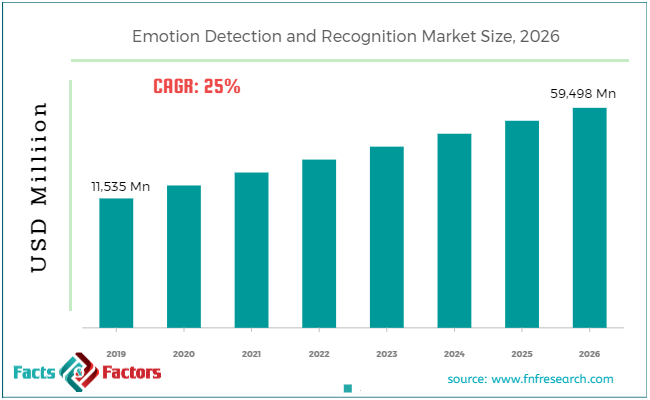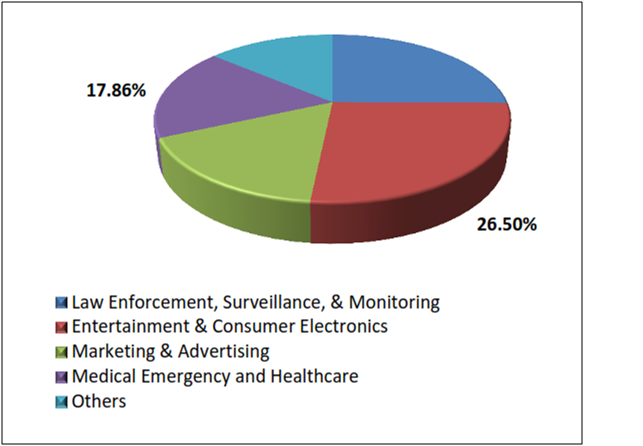Search Market Research Report
Emotion Detection and Recognition Market Size, Share Global Analysis Report, 2019 - 2026

Emotion Detection and Recognition Market By Type (Technology, Software Tool, Service, and Others) and By Application (Law Enforcement, Surveillance, & Monitoring, Entertainment & Consumer Electronics, Marketing & Advertising, Medical Emergency and Healthcare, Others (e-Learning and Video Games)): Global Industry Perspective, Comprehensive Analysis, and Forecast 2019 - 2026
Industry Insights
We have included industry analysis models in our report and extensively demonstrated the key business strategies and competitive landscape of the emotion detection and recognition market in our study.
The report encompasses the forecast as well as an analysis of the emotion detection and recognition market on a global and regional level. The study displays historical data from 2016 to 2019 along with a forecast from 2020 to 2026 based on revenue (USD Million). Additionally, the market growth drivers, opportunities, limitations, and trends are also included in the emotion detection and recognition market report.

 Key Insights from Primary Research
Key Insights from Primary Research
- As per our analysis, the global emotion detection and recognitions market is set to grow annually at a rate of around 25%
- It was established through primary research that the emotion detection and recognition market was valued at around USD 11,500 Million in 2019
- As per the primary inputs, presently the major revenue for this market is coming from the two major application segments namely, law enforcement, surveillance, and monitoring, and entertainment & consumer electronics.
- Both of these application segments contribute to more than 50% of the market revenue
- As per the primary interviews, North America and Europe are the major regions for this market. This two regions in combine are contributing more than 70% of the market revenue. However, the Asia Pacific is anticipated to witness the fastest growth over the forecast period.
 Key Recommendations from Analysts
Key Recommendations from Analysts
- As per our analysis, the global emotion detection and recognition market is in its initial stage and the market is likely to grow significantly in upcoming years
- The market is expected to observe average annual growth rate of 25% in the forecast period.
- B2B companies such as GE, Cisco, Autodesk, and IBM are focusing to use this solutions in marketing activities. It is anticipated to provide strategic advantage to these companies.
- Deployment of emotion detection and recognition solutions in the crucial places such as tourists’ spots, airports, and pubic transports can provide advantage in tackling terrorist activities. This is expected to boost this market over the forecast period.
 Market Attractiveness –
Market Attractiveness –

Our study also includes an analysis of Porter’s Five Forces framework for understanding the competitive strategies used by market competitors. It also encompasses PESTLE analysis and SWOT analysis of players.
The report also offers an in-depth analysis of the market share of each industry player and gives an outline of the market position of key players in the emotion detection and recognition market. Moreover, the study offers wide coverage of key strategic improvements witnessed in the market such as acquisitions & mergers, new product launches, agreements, partnerships, collaborations & joint ventures, R&D activities, and geographical expansion of key players of the emotion detection and recognition market.
The study provides a decisive view of the emotion detection and recognition market by segmenting the wig market based on components, organization size, deployment types, end-use industry verticals, and regions. All the segments have been analyzed based on present and future trends and the market is estimated from 2020 to 2026. The regional segmentation includes the current and forecast demand for North America, Europe, Asia Pacific, Latin America, and the Middle East and Africa.
The global emotion detection and recognition market have been segmented based on type and application in the global and regional areas. The market is estimated as per sale of an industry that is classified into a software tool, technology, and service and applied to law enforcement, surveillance, consumer electronics, marketing, advertising, medical emergency, and healthcare, among others like (e-learning and video games). The emotion detection and recognition market is towering due to the attraction of a well prominent manufacturer and new start-up for security systems, and surveillance and monitoring of borders in defense agencies, the healthcare industry, social media, the automotive industry, online marketing, cognitive service, and consumer behavior analysis.
The global market is anticipated on secondary sources for evaluating the result of the emotion detection and recognition market by using online marketing, social media research, client internal data, and in-house repository. Publicity and marketing are the extensive use of the emotion detection and recognition industry.
 Report Scope
Report Scope
Report Attribute |
Details |
Market Size in 2019 |
USD 11,535 Million |
Projected Market Size in 2026 |
USD 59,498 Million |
CAGR Growth Rate |
25% CAGR |
Base Year |
2019 |
Forecast Years |
2020-2026 |
Key Market Players |
Noldus Information Technology, Tobii AB, Face++, Microsoft Azure, Affectiva, Sightcorp, CrowdEmotion Ltd., Beyond Verbal, IBM. , and others. |
Key Segment |
By Type, Application, and Region |
Major Regions Covered |
North America, Europe, Asia Pacific, Latin America, and the Middle East &, Africa |
Purchase Options |
Request customized purchase options to meet your research needs. Explore purchase options |
 Major players in the emotion detection and recognition market are
Major players in the emotion detection and recognition market are
- Noldus Information Technology
- Microsoft Azure
- Affectiva
- Sightcorp
- Tobii Ab
- Face++
- IBM
- Crowdemotion Ltd.
The lack of strong calculating power is going to be a major challenge for the growth of the emotion detection and recognition industry.
This report segments the Emotion Detection and Recognition market as follows:
 By Type Segment Analysis
By Type Segment Analysis
- Technology
- Software Tool
- Service
 By Application Analysis
By Application Analysis
- Law Enforcement, Surveillance, & Monitoring
- Entertainment & Consumer Electronics
- Marketing & Advertising
- Medical Emergency and Healthcare
- Others (e-Learning and Video Games)
 Global Emotion detection and recognition Market: Regional Segment Analysis
Global Emotion detection and recognition Market: Regional Segment Analysis
- North America
- U.S.
- Canada
- Europe
- Germany
- France
- UK
- Italy
- Spain
- Rest of Europe
- Asia Pacific
- China
- Japan
- India
- South Korea
- South-East Asia
- Rest of Asia Pacific
- Latin America
- Brazil
- Mexico
- Rest of Latin America
- The Middle East and Africa
- GCC Countries
- South Africa
- Rest of Middle-East Africa
 Key Pointers Addressed by the Report
Key Pointers Addressed by the Report
- Historical data and forecast analysis of the market
- Drivers and Restraints affecting market dynamics
- Exhaustive analysis of the future market trends
- Comprehensive information about the leading market segments and regions
- Potential opportunities for the players in the market
- Business strategies by the major players operating in the global market
- Strategic developments made by the competitive players and in-depth analysis of their impact on market growth
Industry Major Market Players
- Noldus Information Technology
- Microsoft Azure
- Affectiva
- Sightcorp
- Tobii Ab
- Face++
- IBM
- Crowdemotion Ltd.
Frequently Asked Questions
Which key factors will influence the Emotion Detection and Recognition Market growth over 2020-2026?

Copyright © 2024 - 2025, All Rights Reserved, Facts and Factors


